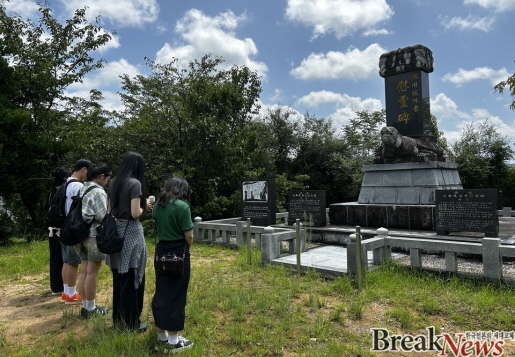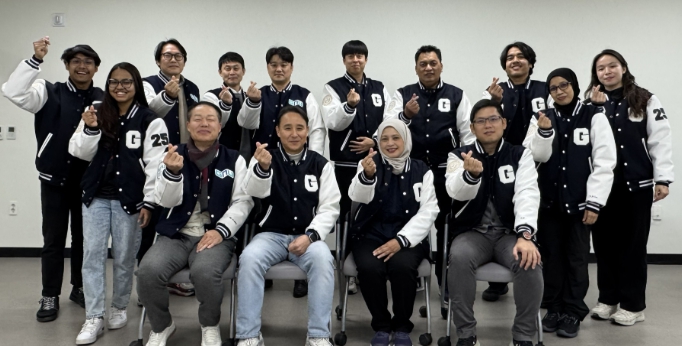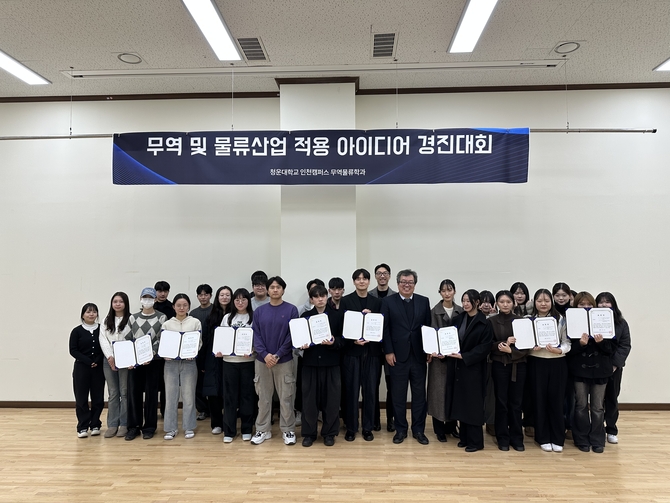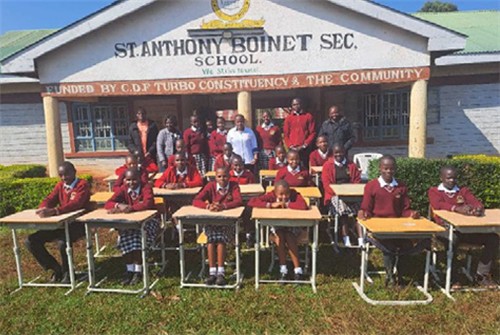
▲ 학생들이 미이케 탄광 조선인 강제징용자들을 위한 위령비 앞에서 참배하고 있다.
(무안=브레이크뉴스) 이학수 기자=전남의 학생들이 일제강점기 강제징용의 참상을 담은 다큐멘터리를 제작하고 있어 눈길을 끈다. 군함도, 아소 탄광, 미이케 탄광 등에서 벌어진 참혹한 실상을 기록해, 그 시절 역사의 아픔을 기리고자 함이다.
삼호고등학교 동아리 ‘컬쳐웍스’(Cultureworks)는 올해 초 특별한 프로젝트 하나를 기획했다. 전라남도교육청 청소년 미래도전 프로젝트로 활동했던 ‘컬쳐웍스’가 우수 팀으로 선정되면서 국외 활동의 기회를 얻게 된 것이 계기가 됐다.
김은서, 박의빈, 조가인, 김하윤, 고시은 등 5명 동아리원은 어떤 주제를 다룰지 고민하다, 일제강점기 온 삶을 박탈당했던 조선인 노동자들의 생애에 주목했다. 가장 먼저 강제징용 관련 서적을 읽고 자료조사에 돌입했다.
주제 특강을 듣고, 지역별 강제징용의 유형과 특성을 조사했다. 일제강점기 강제징용 지도를 제작했고, 연표를 작성했다. 진실에 가깝게 다가갈수록, 교과서에 실린 몇 문단의 글로는 알지 못했던 실상이 적나라하게 드러나기 시작했다.
그러자, 프로젝트의 방향성이 뚜렷해졌다. 희망 없는 탄광에서, 외딴섬에서 노역하다 미처 돌아오지 못한 이들의 비극을 다큐멘터리에 담기로 한 것. 프로젝트 ‘미완의 귀환’은 그렇게 시작됐다.
무더웠던 7월 ‘컬쳐웍스’ 동아리원 5명은 6박 7일간 일본을 다녀왔다. 조선인 수천 명이 강제 노역했던 미이케 탄광을 취재하고, 희생된 노동자들을 추모하는 위령비를 참배했다. 또 혹독한 노동환경으로 악명 높았던 아소 탄광에서 고통의 시간을 보냈던 조선인들의 흔적을 생생하게 담았다. 아소탄광 한편에는 조선인 강제징용 노동자들의 공동묘지가 마련돼 있는데, 학생들은 물과 밥을 고파했을 당시 선조들을 기리며 생수와 빵을 마련해 직접 제를 올리기도 했다.
또, ‘지옥섬’이라 불렸던 군함도에 입도해, 아름다운 경관에 숨겨져 있는 강제 노역 현장 곳곳을 취재했다. 일제강점기 비행장 건설에 동원된 조선인들의 집단 거주지 ‘우토로 마을’에서는 관계자들과 만나 그 시절의 참상을 자세히 들어볼 수 있는 기회도 가졌다. 취재 날은 우토로 마을 평화기념관 휴관일임에도 불구하고, 한국 고등학생들의 자발적인 움직임에 30여 분간 인터뷰에 응해줬다.
마지막으로 광복 후, 고향으로 돌아가기 위해 승선했다가 폭살당한 ‘우키시마호 사건’의 위령비 앞에서는 “이 역사를 잊지 않고 널리 알리겠다”는 다짐을 방명록에 새기기도 했다.
‘컬쳐웍스’ 학생들은 “강제징용의 역사는 인류의 보편적 가치인 인권‧평화가 무시된 사실이 명백함에도 불구하고 사실을 인정하기는커녕, 군함도와 미이케 탄광이 유네스코 세계문화유산에 등재됐다는 게 화가 나고 가슴이 아팠다.”고 입을 모았다.
이어 “열악하고 참혹한 노동 현장을 보면서 경악을 금할 수 없었다. 하지만 더 절망적이었던 것은 어떤 곳에도 조선인들의 강제징용 사실과 잔혹한 학살, 학대에 대한 언급이 없었다는 사실이다.”며 “우리가 이 아픈 역사를 고스란히 영상에 담아 알려야 하는 이유다.”고 밝혔다.
일본 현지 영상 촬영 및 취재를 마친 학생들은 다큐멘터리 ‘미완의 귀향’ 제작을 위한 자료 정리, 편집 활동에 매진하고 있다. 하반기에는 교내에서 다큐멘터리 제작 발표회 및 시사회를 열 예정이다.
최재원 지도교사는 “이 프로젝트는 지난 역사의 아픔을 학생들이 직접 기획‧취재해 강제징용 현장의 참상을 담아냈다는 데 의미가 크다. 학생들은 치유와 화해를 위해서는 반드시 과거에 대한 깊은 성찰과 반성이 선행돼야 한다는 메시지를 전하는 데 주력할 계획이다.”고 전했다.
아래는 위 기사를 '구글 번역'으로 번역한 영문 기사의 [전문] 입니다. '구글번역'은 이해도를 높이기를 위해 노력하고 있습니다. 영문 번역에 오류가 있을 수 있음을 전제로 합니다. The following is [the full text] of the English article translated by 'Google Translate'. 'Google Translate' is working hard to improve understanding. It is assumed that there may be errors in the English translation.
Jeonnam students capture the tragedy of forced labor during the Japanese colonial period in video
Samho High School club ‘Cultureworks’ begins production of documentary ‘Incomplete Return’… Visits Gunhamdo and Miike Coal Mine, etc. “We will not forget the painful history and spread the word”
(Muan=Break News) Reporter Lee Hak-su=Jeonnam students are drawing attention by producing a documentary that captures the tragedy of forced labor during the Japanese colonial period. They want to record the tragic reality that occurred at Gunhamdo, Aso Coal Mine, Miike Coal Mine, etc., and commemorate the pain of history during that time.
Samho High School club ‘Cultureworks’ planned a special project early this year. ‘Cultureworks’, which had been active in the Jeollanam-do Office of Education’s Youth Future Challenge Project, was selected as an excellent team, which gave them the opportunity to work abroad.
The five club members, including Kim Eun-seo, Park Ui-bin, Jo Ga-in, Kim Ha-yoon, and Ko Si-eun, were contemplating what topic to cover, and focused on the lives of Korean workers who were deprived of their entire lives during the Japanese colonial period. First, they read books related to forced conscription and began researching materials.
After listening to a special lecture on the topic, they investigated the types and characteristics of forced conscription by region. They created a map of forced conscription during the Japanese colonial period and created a chronology. As they got closer to the truth, the reality that they had not known from a few paragraphs in textbooks began to be revealed.
Then, the direction of the project became clear. They decided to document the tragedy of those who worked in hopeless coal mines and on remote islands and never returned. That is how the project ‘Unfinished Return’ began.
In the hot month of July, the five members of the ‘Culture Works’ club visited Japan for six nights and seven days. We covered the Miike Coal Mine, where thousands of Koreans were forced to work, and paid our respects at the memorial stone commemorating the sacrificed workers. We also vividly captured the traces of Koreans who suffered in the Aso Coal Mine, which was notorious for its harsh working conditions. On one side of the Aso Coal Mine is a communal cemetery for Korean forced laborers. When students were hungry for water and food, they prepared water and bread to honor their ancestors and held a memorial service.
We also visited Gunkanjima, which was called “Hell Island,” and covered the forced labor sites hidden in beautiful scenery. We also had the opportunity to meet with officials at “Utoro Village,” a collective residence for Koreans who were mobilized to build an airfield during the Japanese colonial period, and hear in detail about the horrors of that time. Even though the Utoro Village Peace Memorial Hall was closed on the day of our reporting, we interviewed Korean high school students for about 30 minutes because of their voluntary action.
Finally, in front of the memorial monument for the Ukishima incident, where people boarded the ship to return home after liberation and were killed, they wrote in the guestbook a pledge to “not forget this history and make it widely known.”
The Culture Works students all said, “The history of forced conscription is clearly a case of ignoring universal human rights and peace, but rather than acknowledging the facts, we were angry and heartbroken that Gunkanjima and Miike Coal Mine were listed as UNESCO World Heritage Sites.”
They continued, “We couldn’t help but be shocked when we saw the poor and miserable labor conditions. However, what was even more desperate was the fact that there was no mention of the forced conscription of Koreans, their brutal massacre, or abuse anywhere.” They continued, “This is why we must make this painful history known through video.”
The students who finished filming and reporting on the site in Japan are now busy organizing and editing materials for the documentary “Unfinished Homecoming.” In the second half of the year, a documentary production presentation and screening will be held on campus.
Supervisor Choi Jae-won said, “This project is significant in that the students directly planned and reported on the pain of past history and captured the tragedy of the forced labor scene. The students plan to focus on conveying the message that deep reflection and introspection on the past must come first in order to achieve healing and reconciliation.”




![[삶과문화] 세상의 끝서 만난 문학 축제](https://img.segye.com/content/image/2025/12/11/20251211519573.jpg)



